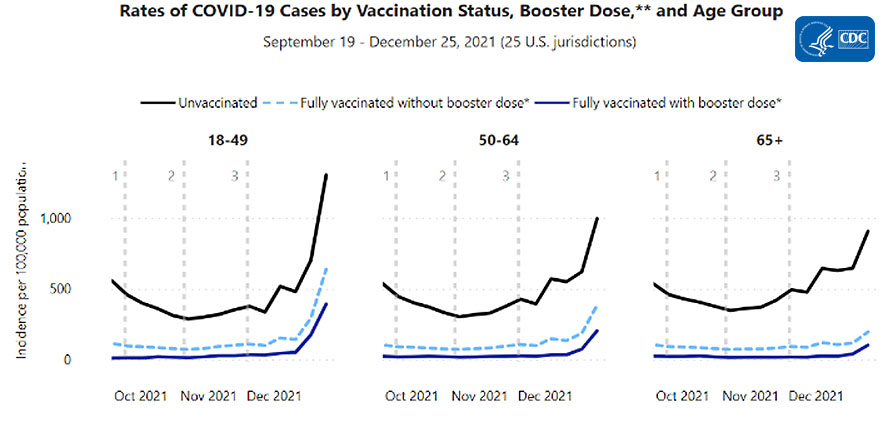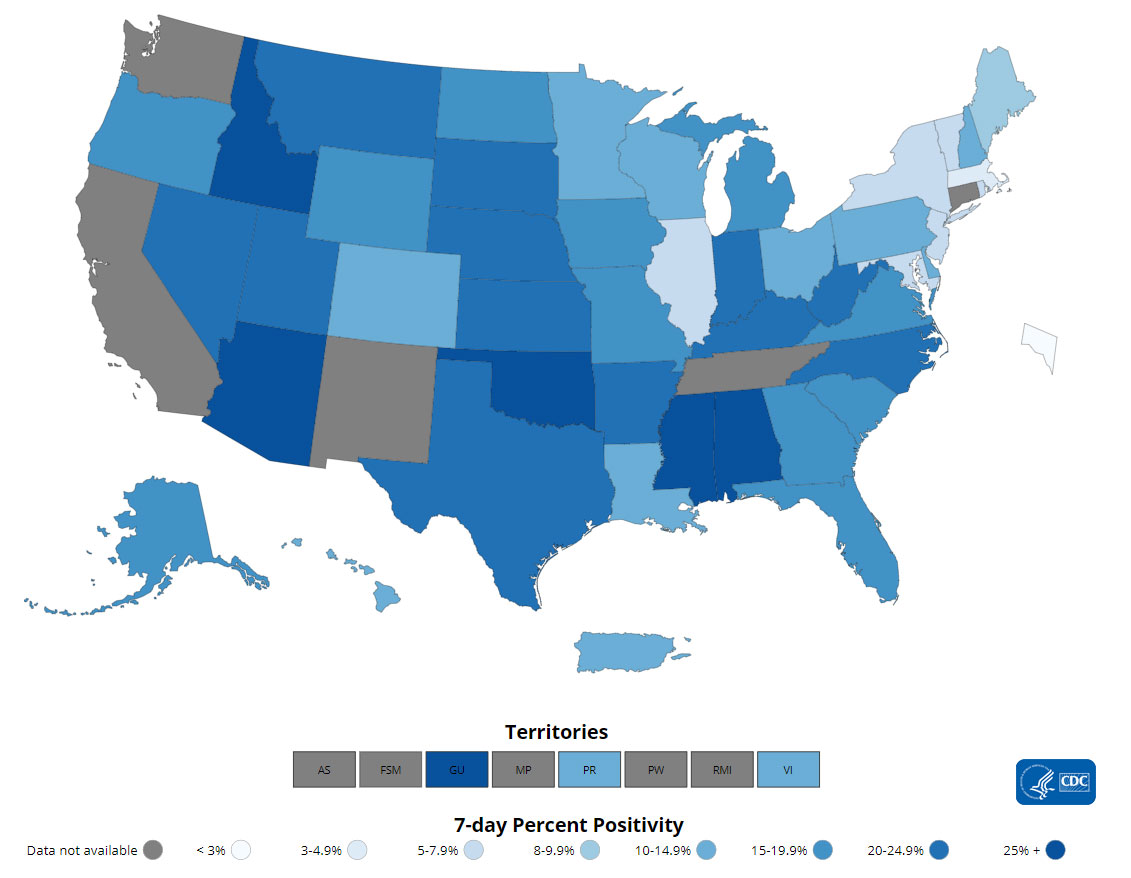Recommendations for Fully Vaccinated People
COVID-19 Homepage
Boosters Work
Interpretive Summary for February 11, 2022
Boosters Work
COVID-19 cases and hospitalizations in January 2022 were the highest since the beginning of the pandemic, fueled by the rapid spread of the Omicron variant. As of February 10, 2022, Omicron is still the predominant variant across the country.
A recent CDC study found that among people hospitalized with COVID-19, severe outcomes during the Omicron period appear lower than during previous high transmission periods. COVID-19 hospital stays were shorter, with fewer intensive care unit stays. Part of the reason for the lower severity is because of vaccination coverage and booster dose uptake among eligible people. COVID Data Tracker shows that as of February 10, 2022, about 213.4 million people, or 64.3% percent of the total U.S. population, have received a primary series of a COVID-19 vaccine.
However, only about half of those eligible to receive a booster dose have done so. Everyone ages 12 years and older should get a booster shot after they have completed their COVID-19 vaccine primary series. Omicron is extremely contagious, and even though overall severity is lower, the high volume of hospitalizations has strained the healthcare system. Being up to date with vaccination, in coordination with other key prevention strategies, is critical for preventing severe illness from COVID-19 and for reducing the likelihood of new variants from emerging. Find a vaccine provider and get your booster dose as soon as you can.
- COVID Data Tracker’s Vaccination Demographics and Vaccination Demographics Trends tabs now include booster dose data among people ages 12 years and older.
- COVID Data Tracker’s County View tab now includes county-level booster dose data for people ages 12 years and older.
- Genomic Surveillance for SARS-CoV-2 Variants: Predominance of the Delta (B.1.617.2) and Omicron (B.1.1.529) Variants — United States, June 2021–January 2022
- Effectiveness of Face Mask or Respirator Use in Indoor Public Settings for Prevention of SARS-CoV-2 Infection — California, February–December 2021
- Clinical Characteristics and Outcomes Among Adults Hospitalized with Laboratory-Confirmed SARS-CoV-2 Infection During Periods of B.1.617.2 (Delta) and B.1.1.529 (Omicron) Variant Predominance — One Hospital, California, July 15–September 23, 2021, and December 21, 2021–January 27, 2022
- Waning Effectiveness of 2-Dose and 3-Dose mRNA Vaccines Against COVID-19–Associated Emergency Department and Urgent Care Encounters and Hospitalizations Among Adults During Periods of Delta and Omicron Variant Predominance — VISION Network, 10 States, August 2021–January 2022
- Safety Monitoring of COVID-19 Vaccine Booster Doses Among Adults—United States, September 22, 2021–February 6, 2022
Reported Cases
As of February 9, 2022, the current 7-day moving average of daily new cases (215,418) decreased 42.8% compared with the previous 7-day moving average (376,855). A total of 77,179,255 COVID-19 cases have been reported in the United States as of February 9, 2022.
Currently two variants, Omicron and Delta, are classified as Variants of Concern (VOC) in the United States. CDC Nowcast projections* for the week ending February 5, 2022, estimate the national proportion of Omicron to be approximately 100%. There are four lineages designated as Omicron: B.1.1.529, BA.1, BA.2, and BA.3. COVID Data Tracker now shows the proportions of the B.1.1.529 lineage (includes BA.1 and BA.3) and the BA.2 lineage. The predominant Omicron lineage continues to be B.1.1.529 (BA.1 and BA.3), which is projected to be 96.4% (95% PI 93.2-98.2%); the BA.2 lineage is projected to be 3.6% (95% PI 1.8-6.8%). Delta is projected to decrease to 0.0% (95% PI 0.0-0.0%). Omicron is predicted to be nearly 100% in all HHS regions.
77,179,255
Total Cases Reported
77,179,255
Total Cases Reported
215,418
Current 7-Day Average***
215,418
Current 7-Day Average***
376,855
Prior 7-Day Average
376,855
Prior 7-Day Average
-42.8%
Change in 7-Day Average since Prior Week
-42.8%
Change in 7-Day Average since Prior Week
*The median time from specimen collection to sequence data reporting is about 3 weeks. As a result, weighted estimates for the most recent few weeks may be unstable or unavailable. CDC’s Nowcast is a data projection tool that helps fill this gap by generating timely estimates of variant proportions for variants that are circulating in the United States. View Nowcast estimates on CDC’s COVID Data Tracker website on the Variant Proportions page.
**Historical cases are excluded from daily new cases and 7-day average calculations until they are incorporated into the dataset for the applicable date. Of 423,466 historical cases reported retroactively, 24,081 were reported in the current week and 136 were reported in the prior week.
Vaccinations
The U.S. COVID-19 Vaccination Program began December 14, 2020. As of February 10, 2022, 545.5 million vaccine doses have been administered in the United States. Overall, about 251.7 million people, or 75.8% of the total U.S. population, have received at least one dose of vaccine. About 213.4 million people, or 64.3% of the total U.S. population, have been fully vaccinated.* About 90.9 million additional or booster doses have been reported in people who have been fully vaccinated; however, 53.2% of the total booster-eligible population has not yet received a booster dose. As of February 10, 2022, the 7-day average number of administered vaccine doses reported (by date of CDC report) to CDC per day was 580,896, an 19.3% decrease from the previous week.
CDC’s COVID Data Tracker Vaccination Demographic Trends tab shows vaccination trends by age group. As of February 10, 2022, 95.0% of people ages 65 years or older have received at least one dose of vaccine and 88.5% are fully vaccinated. For people ages 18 years or older, 87.4% have received at least one dose of vaccine and 74.5% are fully vaccinated. For people ages 12 years or older, 85.5% have received at least one dose of vaccine and 72.9% are fully vaccinated. For people ages 5 years or older, 80.6% have received at least one dose of vaccine and 68.3% are fully vaccinated.
545,477,120
Vaccine Doses Administered
545,477,120
Vaccine Doses Administered
251,655,172
People who received at least one dose
251,655,172
People who received at least one dose
213,430,434
People who are fully vaccinated*
213,430,434
People who are fully vaccinated*
75.8%
Percentage of the U.S. population that has received at least one dose
75.8%
Percentage of the U.S. population that has received at least one dose
64.3%
Percentage of the U.S. population that has been fully vaccinated*
64.3%
Percentage of the U.S. population that has been fully vaccinated*
+0.3
Percentage point increase from last week
+0.3
Percentage point increase from last week
+0.3
Percentage point increase from last week
+0.3
Percentage point increase from last week
*Represents the number of people who have received the second dose in a two-dose COVID-19 vaccine series (such as the Pfizer or Moderna vaccines) or one dose of the single-shot Johnson & Johnson’s Janssen vaccine.
Hospitalizations
New Hospital Admissions
The current 7-day daily average for February 2–February 8, 2022, was 12,099. This is a 25.4% decrease from the prior 7-day average (16,212) from January 26–February 1, 2022.
4,403,630
Total New Admissions
4,403,630
Total New Admissions
12,099
Current 7-Day Average
12,099
Current 7-Day Average
16,212
Prior 7-Day Average
16,212
Prior 7-Day Average
-25.4%
Change in 7-Day Average
-25.4%
Change in 7-Day Average
The start of consistent reporting of hospital admissions data was August 1, 2020.
Daily Trends in Number of New COVID-19 Hospital Admissions in the United States

New admissions are pulled from a 10 am EST snapshot of the HHS Unified Hospital Timeseries Dataset. Due to potential reporting delays, data from the most recent 7 days, as noted in the figure above with the grey bar, should be interpreted with caution. Small shifts in historic data may also occur due to changes in the Centers for Medicare and Medicaid Services (CMS) Provider of Services file, which is used to identify the cohort of included hospitals.
COVID-NET: Hospitalization Rates by Vaccination Booster Status in Adults
CDC’s Coronavirus Disease 2019-Associated Hospitalization Surveillance Network (COVID-NET) shows that rates of COVID-19-associated hospitalizations in December 2021 were noticeably higher in adults who were unvaccinated compared to adults who were fully vaccinated and received additional or booster doses of a COVID-19 vaccine. Among adults ages 50–64 years, the COVID-19-associated hospitalization rate in December among adults who were unvaccinated was 45 times higher than among those who were fully vaccinated and received an additional or booster dose. Among adults ages 65 years and older, compared to persons who were fully vaccinated and received an additional or booster dose, rates of COVID-19-associated hospitalizations were 51 times higher among adults who were unvaccinated.
Hospitalization Rates by Vaccination Booster Status in Adults Aged ≥65 Years

The Coronavirus Disease 2019 (COVID-19)-Associated Hospitalization Surveillance Network (COVID-NET) is an additional source for hospitalization data collected through a network of more than 250 acute-care hospitals in 14 states (representing ~10% of the U.S. population). Detailed data on patient demographics, including race/ethnicity, underlying medical conditions, medical interventions, and clinical outcomes, are collected with a standardized case reporting form.
Deaths
The current 7-day moving average of new deaths (2,313) has decreased 5.9% compared with the previous 7-day moving average (2,459). As of February 9, 2022, a total of 910,373 COVID-19 deaths have been reported in the United States.
910,373
Total Deaths Reported
910,373
Total Deaths Reported
2,313
Current 7-Day Average*
2,313
Current 7-Day Average*
2,459
Prior 7-Day Average
2,459
Prior 7-Day Average
-5.9%
Change in 7-Day Average Since Prior Week
-5.9%
Change in 7-Day Average Since Prior Week
*Historical deaths are excluded from the daily new deaths and 7-day average calculations until they are incorporated into the dataset by their applicable date. Of 20,520 historical deaths reported retroactively, none were reported in the current week; and 192 were reported in the prior week.
Daily Trends in Number of COVID-19 Deaths in the United States Reported to CDC

7-Day moving average
 More Death Data
More Death DataTesting
The percentage of COVID-19 NAATs (nucleic acid amplification tests)* that are positive (percent positivity) is decreasing in comparison to the previous week. The 7-day average of percent positivity from NAATs is now 12.7%. The 7-day average number of tests reported for January 28 – February 3, 2022, was 1,392,546, down 21.0% from 1,762,138 for the prior 7 days.
795,303,990
Total Tests Reported
795,303,990
Total Tests Reported
1,392,546
7-Day Average Tests Reported
1,392,546
7-Day Average Tests Reported
12.7%
7-Day Average % Positivity
12.7%
7-Day Average % Positivity
19.1%
Previous 7-Day Average % Positivity
19.1%
Previous 7-Day Average % Positivity
-6.39
Percentage point change in 7-Day Average % Positivity since Prior Week
-6.39
Percentage point change in 7-Day Average % Positivity since Prior Week
*Test for SARS-CoV-2, the virus that causes COVID-19




